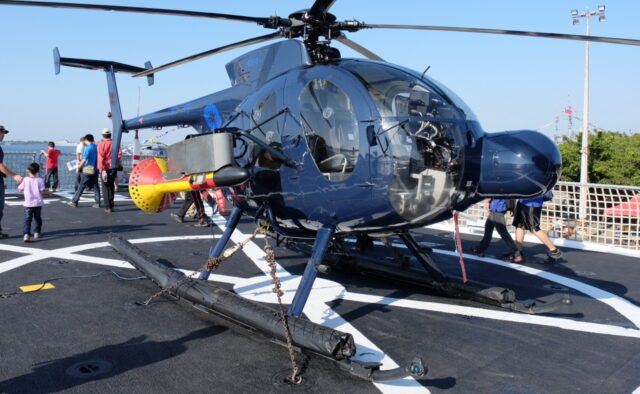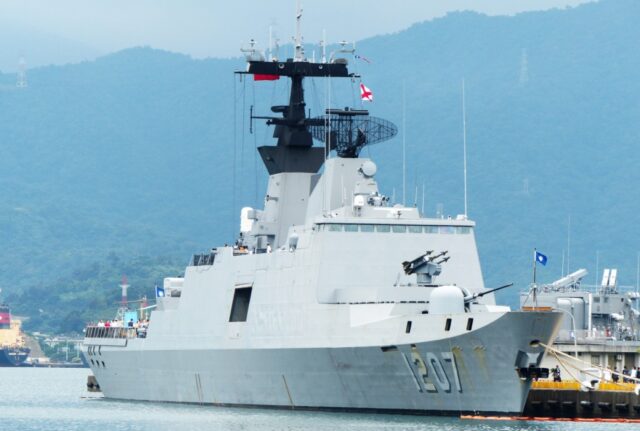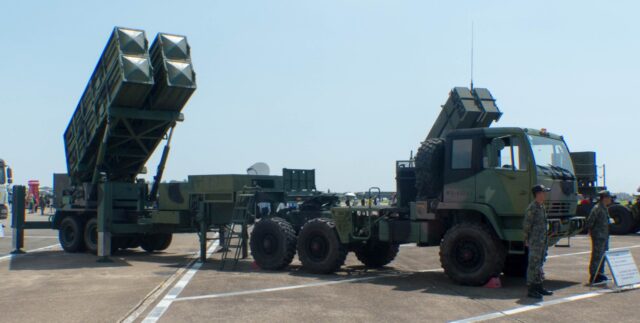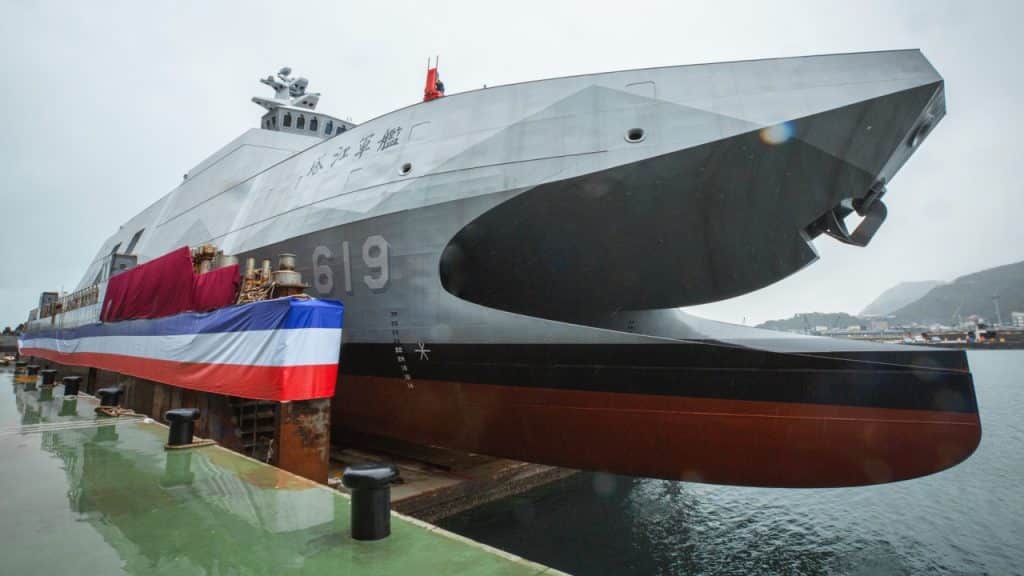The risk of a naval blockade by Chinese submarines prompts Taiwan to seek measures to combat them. The object of interest of the Ministry of Defense of the Republic of China is the construction of ZOP corvettes with their own forces. Another interesting news from recent days is the possibility of joint production of some weapons systems with the United States. The information on this subject is very general, but it can be presumed that Washington will consent to the transfer of technology only those systems it deems necessary to repel a possible invasion from the continent.
Defense Minister Chiu Kuo-cheng announced in his speech on October 11th that the development of ZOP forces would be a priority. This is supposed to be a response to the blockade scenario that China was likely practicing during the maneuvers around Taiwan following Nancy Pelosi’s visit in early August. Maintaining sea and land connections with the rest of the world is a key factor in the event of any conflict with the People’s Republic of China.
The blockade is unequal. If Beijing decides to run it with submarines, it risks escalating rapidly. The experiences of both world wars teach that surface ships can blockade by intercepting merchant ships or turning them back. Submarines have very limited possibilities for such activities. Popping up and contacting civilian units deprives them of their main asset, which is stealth.
In short, if Beijing is actually considering using submarine forces to establish a naval blockade of Taiwan, it is gearing up to sink ships and possibly convoy battles as well. Such a scenario means a full-scale conflict. Gabriel Honrada of the Asia Times points out one unquestionable advantage of submarines related to this development of events. Submarine losses are easier to hide, especially from the public. It is not known how ordinary Chinese would react to photos and recordings of burning and sinking ships under the red flag.
The state of Taiwan’s ZOP forces is far from meeting the needs. The surface ships are optimized in terms of fighting enemy surface units and air defense. Their only armament of the ZOP are the light MK 46 torpedoes. This is the result of an otherwise logical approach that the main task of the fleet will be to fight the invasion forces.
Also the air component does not look very impressive. A dozen P-3C Orion maritime patrol planes, seven small ZOP MD 500MD / ASW Defender helicopters and eighteen larger S-70C (M) -1/2 Thunderhawks can be deployed to fight enemy submarines. Defenders have been in service since 1977, have a limited range and payload, and the Thunderhaws also fulfill SAR tasks, and also have weaker engines and carry a more modest array of weapons than the MH-60 family.

Taiwanese MD 500MD / ASW Defender.
(玄 史 生, Creative Commons Attribution-Share Alike 3.0 Unported)
For this reason, Taipei had been trying to buy ten and then twelve MH-60R Seahawks for several years, but in May this year the plans were abandoned. Minister Chiu openly admitted that the reason was a price that was not compatible with the budget of the Ministry of Defense. The price of helicopters with weapons, logistics and training packages probably exceeded one billion dollars, and the delivery dates were promising to be distant.
The construction of light ZOP ships has therefore become an attractive option. However, another problem arose – such units had never been built in Taiwan. As in the case of the domestic IDS submarines, it would be necessary to divide the necessary technologies and components into three categories called zones: red, yellow and gray. The “red zone” includes elements and skills that Taiwan does not have and is unable to develop on its own. The “yellow zone” includes elements and technologies that are difficult to obtain from abroad, but those that can be independently developed and produced. Finally, the “gray area” covers everything that has already been developed and put into production in Taiwan.

Taiwanese frigate Wu Chang.
(玄 史 生, Creative Commons Attribution-Share Alike 3.0 Unported)
The IDS, of course, can also be used to hunt enemy submarines, and it will probably become one of the main tasks for these units over time, especially since Taipei intends to build a total of eight submarines.
However, it must be remembered that the Taiwanese ZOP corvettes, at least in the first phase of the war, will have to operate under conditions of sea and air superiority of the enemy. In such conditions, an attractive option may be to adapt to the new tasks of the fast stealth corvettes in the Tuo Chiang type catamaran system (in the title image). Limited detectability, a maximum speed of up to 45 knots and powerful for ships with a displacement of about 600 tons, the armament of 12-16 HF-2 and HF-3 anti-ship missiles are to ensure the possibility of carrying out quick attacks on the invasion fleet. There are two such units in service, the third was launched in September this year, and plans include the construction of nine more.
The third Tuo Chiang class hull (2nd Ta Chiang hull) has been lunched. But do you know her name is Fu Chiang (富 江)? It happens to be the name of a famous figure in Japanese horror pop culture. pic.twitter.com/s7eWPmJdIV
– Taepodong (@ stoa1984) September 21, 2022
It would not be unusual to develop a variant of Tuo Chiangów’s ZOP. The hulls of this type of units must be assessed as very useful, because in 2015 the idea of building anti-aircraft corvettes appeared. The units were to be armed first with the TC-1 short-range system, and then even with the Tien Kung III medium-range systems. There was even talk of incorporating corvettes into Taiwan’s missile defense system. Apparently, stuffing a medium-range AA system into such a small hull was too ambitious an idea, and the whole project was quietly shelved.
Production of American weapons
The expansion of Taiwan’s ZOP forces could be easier if the plans to launch US arms production in Taiwan are implemented. Such an option is to be considered by the Biden administration, Nikkei Asia reported, citing three independent sources. According to one of them, preliminary talks on this matter were even to begin.

Taiwan Tien Kung anti-aircraft missile launcher Ⅱ.
(玄 史 生)
It is not about licensed production, but about the joint production of specific systems, which means the inclusion of Taiwanese manufacturers in the supply chains of American companies, broader than just semiconductors. In this way, Washington would not only signal Beijing, but also make Wall Street gain an interest in defending Taiwan’s independence.
However, this is not just the point. As we have already reported, the US defense industry has been hit by a harvest disaster. Current production capacities make it impossible to quickly fulfill growing orders. In the case of Taiwan, the order for a total of forty HIMARSs with ATACMS ballistic missiles is to be completed by 2027. The delivery of one hundred Harpoon coastal defense system kits with 400 RGM-84L-4 Harpoon Block II missiles is expected to last until 2028.
There are several obstacles in the way of implementing such a plan, and especially technology transfer. The first is counterintelligence protection. It has been known for a long time that Taiwan faces serious espionage problems. The local authorities and the army are the subject of large-scale operations by Chinese services. Last year, Chinese spies even managed to obtain information on the security of President Tsai Ing-wen. In such a situation, it is doubtful that the Pentagon will accept the inclusion of Taiwanese companies in the production of the most advanced equipment and the wide transfer of the most advanced technologies.
There are also disagreements between Washington and Taipei about the equipment they need. The consent applies, for example, to HIMARS and Stingers. The Americans, however, believe that Taiwan should, in fact, only invest in asymmetric capabilities. The Taiwanese do not deny such an approach, but do not want to neglect conventional capabilities, such as ZOP ships. Taipei has reasonable arguments to defend itself. Giving up the modernization of fighters or large surface ships means depriving ourselves of the possibility of reacting to Chinese provocations in the Taiwan Strait. There are serious concerns that such an informal abandonment of its own waters and air defense identification zone would only make Beijing impudent.
See also: Drones shot down other drones using microwaves and ribbons
總統府, Creative Commons Attribution 2.0 Generic

